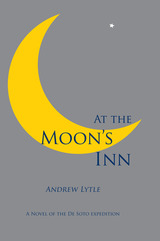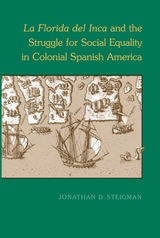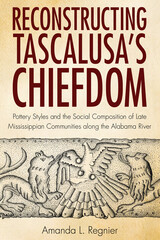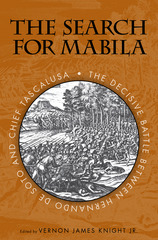4 books about Soto, Hernando de

At the Moon's Inn
Andrew Lytle
University of Alabama Press, 2009
A fascinating tale that brings to life the history of Spanish efforts to establish a controlling presence in the New World during the first half of the 16th century
At the Moon’s Inn, first published in 1941, provides a fictional account of De Soto’s famous Spanish expedition to La Florida and through the southeastern United States between 1539 and 1543. The novel begins in Spain in 1538, where De Soto and his chief lieutenants, veterans of the campaigns in South America, pledge themselves to a new enterprise to explore and exploit La Florida. The narrative follows them on their voyage to Cuba, where they rest and obtain additional supplies, then set sail for the area now known as Tampa Bay. Lytle’s brilliant historical novel takes the readers with the conquistadores through the hot, humid land, where despite their advantage in military technology they found they must rely on the Indians for food. The author explores the cultural confrontation that seriously weakened the Indians, while the Spaniards’ dreams of gold gradually turned to hopes of survival in the hostile environment.
Drawing his facts from the 1939 United States De Soto Commission Report and from the surviving historical chronicles of the expedition, Lytle weaves a fascinating tale that brings to life the history of Spanish efforts to establish a controlling presence in the New World during the first half of the 16th century.
In his introduction, Douglas Jones places At the Moon’s Inn within the context of the documentary record, as well as within the framework of its distinguished author’s career.
At the Moon’s Inn, first published in 1941, provides a fictional account of De Soto’s famous Spanish expedition to La Florida and through the southeastern United States between 1539 and 1543. The novel begins in Spain in 1538, where De Soto and his chief lieutenants, veterans of the campaigns in South America, pledge themselves to a new enterprise to explore and exploit La Florida. The narrative follows them on their voyage to Cuba, where they rest and obtain additional supplies, then set sail for the area now known as Tampa Bay. Lytle’s brilliant historical novel takes the readers with the conquistadores through the hot, humid land, where despite their advantage in military technology they found they must rely on the Indians for food. The author explores the cultural confrontation that seriously weakened the Indians, while the Spaniards’ dreams of gold gradually turned to hopes of survival in the hostile environment.
Drawing his facts from the 1939 United States De Soto Commission Report and from the surviving historical chronicles of the expedition, Lytle weaves a fascinating tale that brings to life the history of Spanish efforts to establish a controlling presence in the New World during the first half of the 16th century.
In his introduction, Douglas Jones places At the Moon’s Inn within the context of the documentary record, as well as within the framework of its distinguished author’s career.
[more]

La Florida del Inca and the Struggle for Social Equality in Colonial Spanish America
Jonathan D. Steigman
University of Alabama Press, 2005
A cross-disciplinary view of an important De Soto chronicle.
Among the early Spanish chroniclers who contributed to popular images of the New World was the Amerindian-Spanish (mestizo) historian and literary writer, El Inca Garcilaso de la Vega (1539-1616). He authored several works, of which La Florida del Inca (1605) stands out as the best because of its unique Amerindian and European perspectives on the De Soto expedition (1539-1543). As the child of an Indian mother and a Spanish father, Garcilaso lived in both worlds--and saw value in each. Hailed throughout Europe for his excellent contemporary Renaissance writing style, his work was characterized as literary art. Garcilaso revealed the emotions, struggles, and conflicts experienced by those who participated in the historic and grandiose adventure in La Florida. Although criticized for some lapses in accuracy in his attempts to paint both the Spaniards and the Amerindians as noble participants in a world-changing event, his work remains the most accessible of all the chronicles.
In this volume, Jonathan Steigman explores El Inca’s rationale and motivations in writing his chronicle. He suggests that El Inca was trying to influence events by influencing discourse; that he sought to create a discourse of tolerance and agrarianism, rather than the dominant European discourse of intolerance, persecution, and lust for wealth. Although El Inca's purposes went well beyond detailing the facts of De Soto’s entrada, his skill as a writer and his dual understanding of the backgrounds of the participants enabled him to paint a more complete picture than most--putting a sympathetic human face on explorers and natives alike.
[more]

Reconstructing Tascalusa's Chiefdom
Pottery Styles and the Social Composition of Late Mississippian Communities along the Alabama River
Amanda L. Regnier
University of Alabama Press, 2014
Reconstructing Tascalusa’s Chiefdom is an archaeological study of political collapse in the Alabama River Valley following the Hernando de Soto expedition.
To explain the cultural and political disruptions caused by Hernando de Soto's exploration deep into north America, Amanda L. Regnier presents an innovative analysis of ceramics and theory of cultural exchange. She argues that culture consists of a series of interconnected models governing proper behavior that are shared across the belief systems of communities and individuals. Historic cognitive models derived from ceramic data via cluster and correspondence analysis can effectively be used to examine these models and explain cultural exchange.
The results of Regnier's work demonstrate that the Alabama River Valley was settled by populations migrating from three different regions during the late fifteenth century. The mixture of ceramic models associated with these traditions at Late Mississippian sites suggests that these newly founded towns, controlled by Tascalusa, comprised ethnically and linguistically diverse populations. Perhaps most significantly, Tascalusa's chiefdom appears to be a precontact example of a coalescent society that emerged after populations migrated from the deteriorating Mississippian chiefdoms into a new region.
A summary of excavations at Late Mississippian sites also includes the first published chronology of the Alabama River from approximately AD 900 to 1600.
[more]

The Search for Mabila
The Decisive Battle between Hernando de Soto and Chief Tascalusa
Edited by Vernon James Knight Jr.
University of Alabama Press, 2009
One of the most profound events in sixteenth-century North America was a ferocious battle between the Spanish army of Hernando de Soto and a larger force of Indian warriors under the leadership of a feared chieftain named Tascalusa. The site of this battle was a small fortified border town within an Indian province known as Mabila. Although the Indians were defeated, the battle was a decisive blow to Spanish plans for the conquest and settlement of what is now the southeastern United States. For in that battle, De Soto’s army lost its baggage, including all proofs of the richness of the land—proofs that would be necessary to attract future colonists. Facing such a severe setback, De Soto led his army once more into the interior of the continent, where he was not to survive. The ragtag remnants of his once-mighty expedition limped into Mexico some three years later, thankful to be alive. The clear message of their ordeal was that this new land, then known as La Florida, could not be easily subjugated.
But where, exactly, did this decisive battle of Mabila take place? The accounts left by the Spanish chroniclers provide clues, but they are vague, so lacking in corroboration that without additional supporting evidence, it is impossible to trace De Soto’s trail on a modern map with any degree of certainty. Within this volume, 17 scholars—specialists in history, folklore, geography, geology, and archaeology—provide a new and encouragingly fresh perspective on the current status of the search for Mabila. Although there is a widespread consensus that the event took place in the southern part of what is now Alabama, the truth is that to this day, nobody knows where Mabila is—neither the contributors to this volume, nor any of the historians and archaeologists, amateur and professional, who have long sought it. One can rightfully say that the lost battle site of Mabila is the predominant historical mystery of the Deep South.
[more]
READERS
Browse our collection.
PUBLISHERS
See BiblioVault's publisher services.
STUDENT SERVICES
Files for college accessibility offices.
UChicago Accessibility Resources
home | accessibility | search | about | contact us
BiblioVault ® 2001 - 2024
The University of Chicago Press









